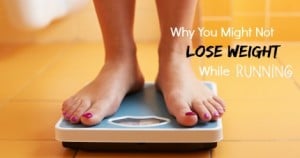There’s a saying that I simply love as a coach and athlete: Simple ain’t easy.
This phrase applies to a lot of what we hope to accomplish as runners to get healthy, get fitter, and lose weight.
If you’re trying to lose weight, it’s likely that you know you need to consume less calories than you burn to see results.
Fad diets, restricting foods, fasting, and all the other marketing-hyped tricks still rely on the basic fact that you must be in a calorie deficit to lose weight.
That’s the simple part. It’s pretty basic science.
But, actually “doing it” isn’t quite as easy. Why is this?
Because you need to know how many calories you’re burning. You need to know the amount of calories in everything you eat and drink. You have to keep track of all these calories each and every day so you can make sure you get under the amount of calories burned.
That tracking can be monotonous, boring, and difficult to stick to. But it works.
Now, where does that leave us in regards to the title of this article.
Why is it that you’ve reduced you calorie intake and you’re eating “almost nothing” every day and you increased your mileage.
There’s no way you’re not in a calorie deficit.
Yet, you’re not losing any weight and in some cases you may actually be gaining weight.
What the heck is going on?
Let’s take a look at the actual science on what is happening.
Reason 1: Your basal metabolic rate slows down
When calculating how many calories you’re burning per day, we always start with your “basal metabolic rate”. This is basically how many calories you burn when you’re at rest.
This is usually calculated based on scientific data based on your height, age, weight, etc. and will be slightly different for everyone, but is pretty accurate.
Now, the problem is that when you’re body is in a calorie deficit, hormonal adoptions to leptin, your thyroid, and testosterone cause your basal metabolic rate to slow down.
If your weight loss targets are gradual, like 300-600 calories below your daily intake then these hormonal changes are not too severe and you can progressively lose weight.
When you go to the extreme, like “eating almost nothing”, then these hormonal changes are more significant and your metabolism slows to a basic crawl. This not only makes you feel like crap, but halts any weight loss because it’s nearly impossible to be in a deficit.
This is the main reason you’ll stall or might even gain weight when on a crash diet.
Reason 2: Your “thermic effect of food” decreases.
The thermic effect of food, or TEF, is the amount of energy required to eat, digest, absorb, and store food.
Research shows that TEF accounts for about 10% of total daily energy expenditure, which is not an insignificant amount.
Now, if you’re eating almost no food, then you run into the issue that you’re reducing 5-8% of your daily calorie expenditure.
That’s not a ton on its own, but as you’ll see below, the calorie reductions continue to pile up.
Reason 3: You burn less energy through “spontaneous” physical activity.
Believe it or not, you actually burn a significant number of calories just in the subtle, spontaneous activity we do every day.
This could be walking around while talking on the phone, drumming your thumbs, or other weird ticks you do that you may not even realize.
The energy burned by these activities is known as non-exercise activity thermogenesis, or NEAT, and it plays a much larger role in total daily energy expenditure than most people realize.
Research shows that NEAT can vary by up to 2,000 calories per day among individuals, and the same research indicates that people could lose an additional 350 calories per day when your body naturally reduces these spontaneous activities.
Reason 4: You burn less energy during exercise.
Now let’s address the idea that you’re running more than you were before you started to try and lose weight.
Not only does this put you in a potential hormonal imbalance like I mentioned above, but as you reduce your calories to sparse levels, the amount of energy expended during exercise actually decreases.
So, now you’re burning less calories for every mile you run. Ouch.
Combining all these factors.
As you can see, your total daily energy expenditure can vary significantly. Let’s look at the math…
-200 calories from your metabolism slowing
-100 calories from TEF reduction
-150 calories lost from less NEAT
-100 calories from less energy use when running
—————————————————————–
-550
That means you’re burning 550 calories less than you thought. With your already very low calorie consumption, there’s no way you can put yourself in a calorie deficit.
In fact, a further calorie deficit or increasing exercise time only exasperates those numbers and has you fighting an uphill battle.
As you can see, while no single element is critical in itself, when you combine them all, you can see that the reductions in your energy expenditure, or amount of calories burns, gets so low that it’s near impossible to lose weight.
Nab Our FREE 4-part Weight Loss Email Course
You'll learn the science behind losing weight and still running well so you can understand the "why" of weight loss for long-term success.
Lessons include why simply running more and eating less won't help you lose weight, why your weight fluctuates each day, and the best way to distribute calories throughout your day. Plus more...
How to get back on track
The trick to losing weight is to be consistent and accurate with your calorie tracking.
Just eating as little as you can and running more will not result in weight loss – it may even result in weight gain.
You also can’t just “estimate” how many calories you’re burning and how many you’re taking in. This almost never works!
You need to get specific. That means not only knowing what your basal metabolic rate is, but factoring in how many miles you ran and what pace you ran them at.
Likewise, you need to track what you’re taking in, keep a log, and make sure you hit your target number.
Simple.
But, not always easy.
Step 1: Get your calorie expenditure right
The first step is getting an accurate look at how many calories you’re burning. This means you basal metabolic rate (which factors in age, weight, gender) plus your “general activity level” and then add in your running.
If you need, we have a calorie expenditure calculator included as part of our 30 day weight loss challenge.
This is essential You can’t skip this step.
Step 2: Target a calorie reduction that is realistic
Like I’ve discussed in this article, you can’t just eat as little as you can and expect results. This will screw up your hormones, not to mention your running.
I recommend shooting for a 300 calorie deficit if you’re training for a race in the next 16 weeks. This is a gradual reduction that can still give you the energy you need to train well.
If you are not training for a race, shoot for a 500 calorie deficit. This will be hard, but won’t trigger adverse adaptations from your body.
Step 3: Track everything you put in your body
This isn’t easy. It’s pretty simple, but not easy.
You can use apps, an excel spreadsheet, or any method you like. Just simply record the calories and macros of everything you eat.
Don’t guess. Read labels or look up items online.
If you do this for 3-4 weeks, you’ll see results. Not drastic results, but long-term results.
Unlike fad diets, which show dramatic results quickly because it’s mostly water and glycogen loss, this method will set you up to be healthy and keep the weight off.
Just remember, weight loss can be simple, but simple isn’t easy. But, what is the joy or gratification in achieving any goal if it’s easy!







